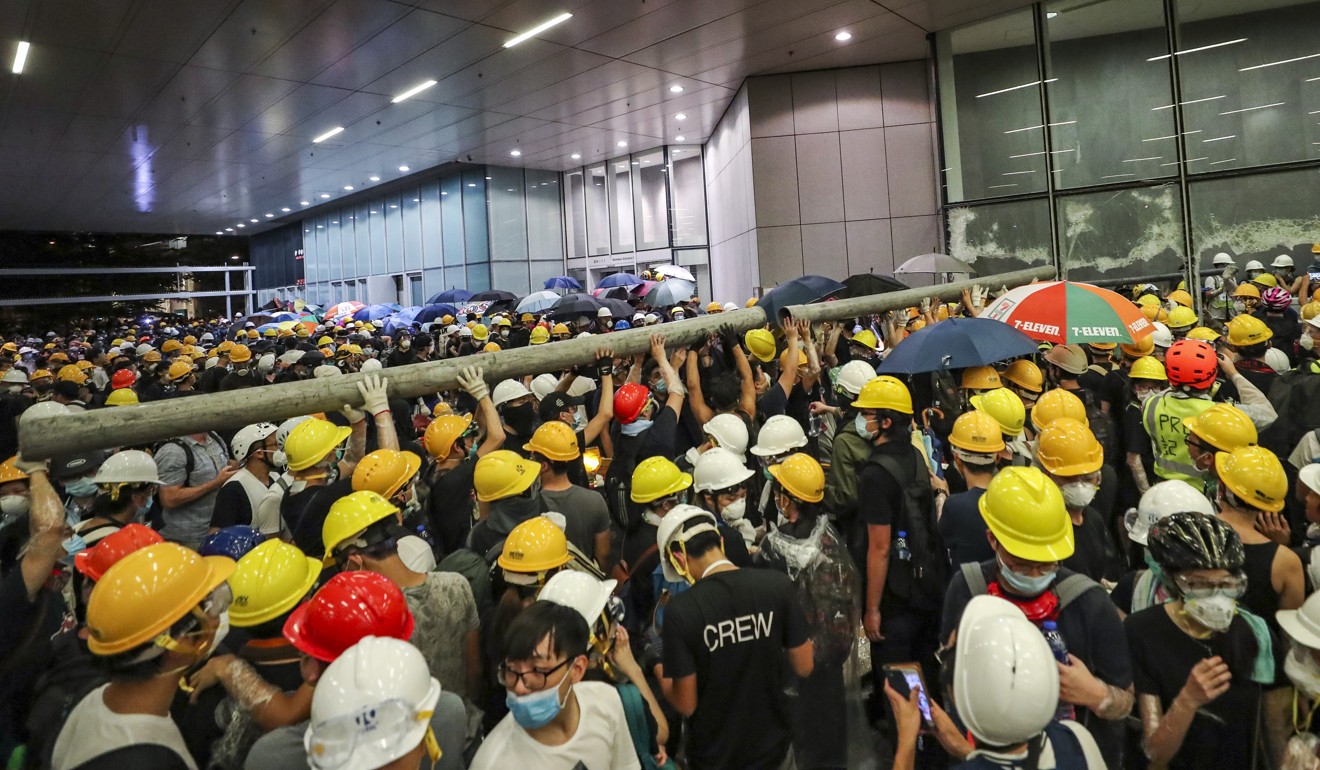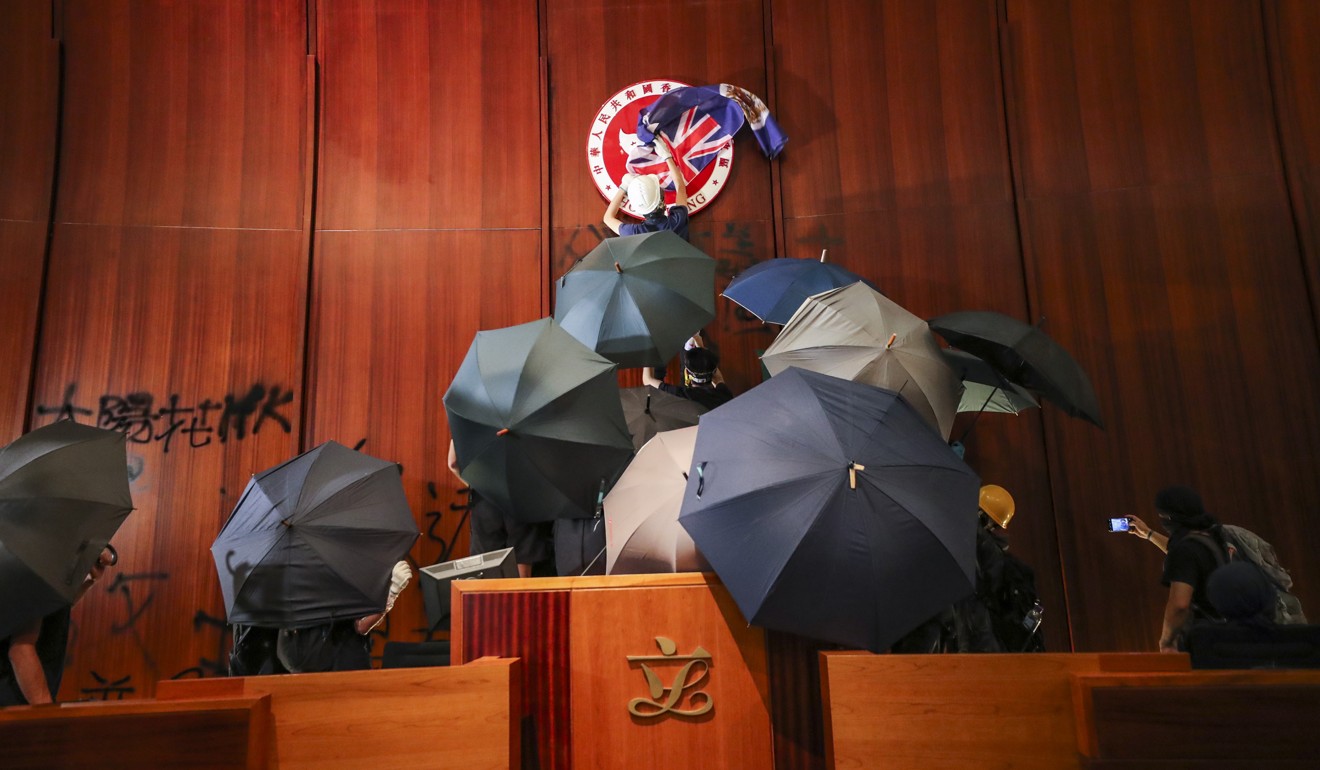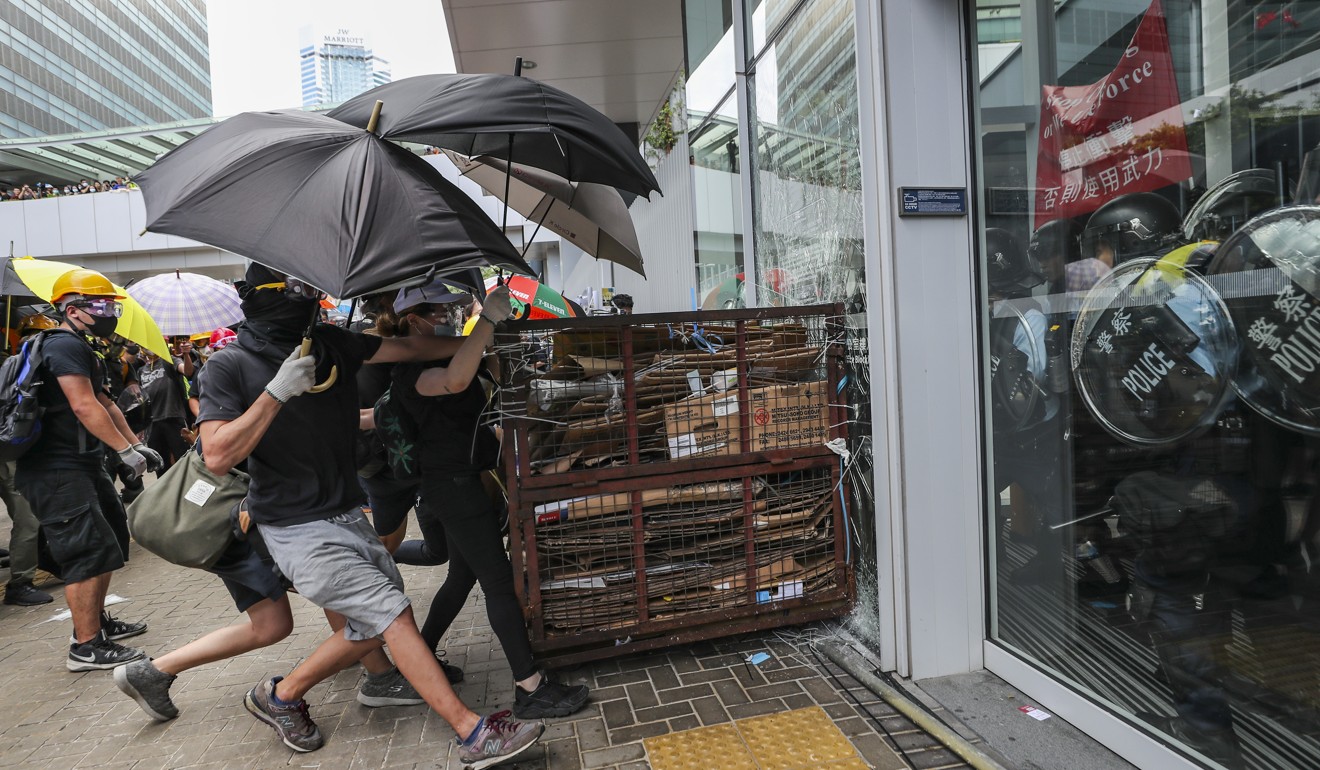
The storming of Hong Kong’s legislature: the inside story of how a plan was hatched on the fly by a small core of young protesters
- Group of about 200 took poll on options at noon on Monday, with 80 per cent voting to storm Legco
- Protesters admitted they had no concrete plan as they proceeded to break into legislature building
The storming of Hong Kong’s legislature on Monday was not a grand scheme hatched by protesters after much debate but emerged from a small group discussion and executed seemingly on the fly.
The picture of an almost spontaneous action that snowballed into shocking scenes of mayhem and violence emerged after the Post pieced together interviews with protesters and observations on the ground.
Unlike the previous actions of the anti-extradition movement, protesters had broken into an unguarded Legislative Council on Monday night without first drawing up a road map on their online platforms. Instead, a group of about 30 protesters on Harcourt Road made the decision at 11.30am on Monday to opt for more forceful measures.
A young man in a green mask was seen trying to gather other protesters, some of whom were still recovering from a clash with police earlier in Wan Chai, to vote on the trajectory of further actions.
“Now, show your hands if you agree to escalate and go radical,” he asked them.
Most of those in the group raised their hands. When asked if they wished to remain peaceful, no hands went up.
The decision was then conveyed to a larger group of about 200 protesters at the Legislative Council’s protest zone at noon.
Random members of the group then threw up ideas on what they could do. Five proposals – replacing the Chinese national flag at Golden Bauhinia Square with a black flag, besieging a venue in Hung Hom that Chief Executive Carrie Lam Cheng Yuet-ngor was set to be at on Monday night, storming Legco, government headquarters or government house – were then discussed and put to a vote.

A 26-year-old male protester, who declined to be named, said one proposal had the clear majority.
“Eighty per cent supported storming Legco,” he said, adding that there was no concrete plan on how to execute the decision.
While some wanted to delay the action until more people showed up after joining the July 1 march, he said this suggestion was rejected.
“They said those who want to be peaceful would only try to stop you,” he said.
Police clear protesters occupying legislature after day of chaos
Others also feared any further delay would only allow police to get prepared.
University student Nick Yeung, 22, said protesters wanted to send a stronger message with more aggressive actions.
“We decided to occupy Legco and paralyse it to make the authorities face our demands,” Yeung said.

As to why Legco was chosen and not other buildings, he said its proximity made it a natural target.
Yeung revealed several participants raised the issue of legal risks and broached the idea of taking more peaceful actions “but such ideas were binned immediately”.
“We didn’t discuss what would happen if we got arrested,” he said.
We didn’t discuss what would happen if we got arrested
Yeung did not take part in the planned storming and left to join the July 1 march that was set to begin at Victoria Park.
Protesters were then seen throwing poles and scrap metal, which they had been collecting for the whole morning, onto a metal trolley, turning the fully loaded cart into a battering ram to smash the glass wall of the building.

At 1.30pm, a handful of protesters were seen charging into glass panels near an entrance on Tim Mei Avenue with a metal cart and poles, while others stood behind to support.
This happened as about 40 police officers – some with riot shields, gas masks and rifles – stood on the other side of the entrance.
At 4pm, half of one glass panel that bore the brunt of the battering was gone, but protesters hung back and did not move into the legislature.
About one hour later, the protesters – now forming a larger group – then went to the entrances closer to Legco’s protest zone, near Tamar Park. They broke glass panels and then proceeded to take down metal bars on a gate.

Again, police took no action against this group, which by now had grown in strength, merging with the hundreds gathered in the protest zone.
During the hours of trying to smash the glass doors and dismantle the metal barriers, several protesters admitted to not having any concrete plan.
“This is an outpouring, after peaceful processions have proven useless,” one said.
‘Outraged’ Hong Kong leader vows to pursue violent protesters ‘to the end’
Moments before protesters finally breached the main entrance at 9pm, some protesters tried to persuade others not to enter the legislature.
“Come back! There are police inside and it’s all locked down, there’s no point in storming! It will just send you to jail!” some shouted.
But others followed the sound of an air horn and moved inside, before others still broke more glass panels to create more entrances.
Some were then seen damaging Legco property, such as portraits of past and incumbent presidents, as well as spraying graffiti on walls.

“You taught me that peaceful protests are useless,” one read.
There was further confusion after protesters found their way into Legco’s iconic chamber, recreating a scene reminiscent of the Sunflower movement in Taiwan in 2014, when students occupied the self-ruled island’s legislature in Taipei for over 20 days.
Some protesters proceeded to spray-paint slogans inside the chamber, such as “Carrie Lam step down” and “release the protesters”.
They were also seen defacing Hong Kong’s bauhinia emblem on the chamber wall.
While some words on the emblem were untouched – “Hong Kong Special Administrative Region” – protesters painted “of the People’s Republic of China” black.
A colonial flag was draped across the podium in the chamber but later removed.
At the end, protesters left four black and white posters of mug shots and a banner that read: “There are no mobs, only tyrannical rule.”
The four pictured were the city’s leader Carrie Lam Cheng Yuet-ngor, security minister John Lee Ka-chiu, justice minister Teresa Cheng Yeuk-wah, and police commissioner Stephen Lo Wai-chung.
Soon after breaking into the chamber, it became clear the protesters were not planning to occupy the chamber, however, as some were seen calling for others to leave, fearful of police moving in to disperse them.
After rounds of deliberation, four protesters who were determined to stay no matter the consequences, remained.
A masked protester read out a manifesto inside the chamber.
“So far three young people have died for the anti-extradition movement. Our hearts are with our home and we sacrifice our bodies to protect it,” he said.

He was referring to three people who had left messages about the extradition bill before taking their lives.
“We don’t want any more lives lost for Hong Kong’s democracy and freedom,” the masked protester said.
The small group were eventually carried out by other protesters past midnight, after police announced their plan to clear the area.
Unprecedented violence in Hong Kong as protesters storm legislature, police fire tear gas
Baptist University assistant professor Edmund Cheng Wai said protesters who wanted to escalate their actions may have avoided putting them on online platforms, knowing it would not win majority support from the larger movement.
“The escalation on Monday was probably not what most had expected,” Cheng said, adding that acts like writing graffiti were rare in Hong Kong.
He said that by not showing their hand online, protesters could have kept the decision to storm Legco as a surprise to law enforcement.
He said if the government did not change its approach to responding to the movement, the protests would continue to escalate in intensity.
Additional reporting by Alvin Lum and Chris Lau


